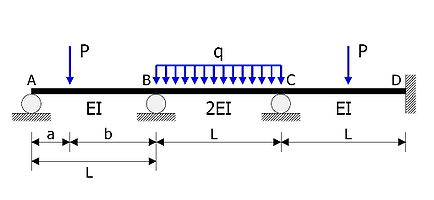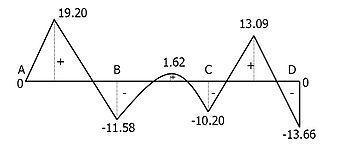- Moment distribution method
-
The moment distribution method (not to be confused with moment redistribution) is a structural analysis method for statically indeterminate beams and frames developed by Hardy Cross. It was published in 1930 in an ASCE journal.[1] The method only accounts for flexural effects and ignores axial and shear effects. From the 1930s until computers began to be widely used in the design and analysis of structures, the moment distribution method was the most widely practiced method.
Contents
Introduction
In the moment distribution method, every joint of the structure to be analysed is fixed so as to develop the fixed-end moments. Then each fixed joint is sequentially released and the fixed-end moments (which by the time of release are not in equilibrium) are distributed to adjacent members until equilibrium is achieved. The moment distribution method in mathematical terms can be demonstrated as the process of solving a set of simultaneous equations by means of iteration.
The moment distribution method falls into the category of displacement method of structural analysis.
Example
The statically indeterminate beam shown in the figure is to be analysed.
- Members AB, BC, CD have the same length
 .
. - Flexural rigidities are EI, 2EI, EI respectively.
- Concentrated load of magnitude
 acts at a distance
acts at a distance  from the support A.
from the support A. - Uniform load of intensity
 acts on BC.
acts on BC. - Member CD is loaded at its midspan with a concentrated load of magnitude
 .
.
In the following calcuations, counterclockwise moments are positive.
Fixed end moments
See also: Fixed end momentFlexural stiffness and distribution factors
The flexural stiffness of members AB, BC and CD are
 ,
,  and
and  , respectively. Therefore:
, respectively. Therefore:The distribution factors of joints A and D are DAB = 1 and DDC = 0.
Carryover factors
The carryover factors are
 , except for the carryover factor from B to A which is zero.
, except for the carryover factor from B to A which is zero.Moment distribution
Numbers in grey are balanced moments; arrows ( → / ← ) represent the carry-over of moment from one end to the other end of a member.
- Step 1
- As joint A is released, balancing moment of magnitude equal to the fixed end moment
 develops and is carried-over from joint A to joint B.
develops and is carried-over from joint A to joint B.
- Step 2
- The unbalanced moment at joint B now is the summation of the fixed end moments
 ,
,  and the carry-over moment from joint A. This unbalanced moment is distributed to members BA and BC in accordance with the distribution factors DBA = 0.2727 and DBC = 0.7273. Step 2 ends with carry-over of balanced moment
and the carry-over moment from joint A. This unbalanced moment is distributed to members BA and BC in accordance with the distribution factors DBA = 0.2727 and DBC = 0.7273. Step 2 ends with carry-over of balanced moment  to joint C. Joint A is a roller support which has no rotational restraint, so moment carryover from joint B to joint A is zero.
to joint C. Joint A is a roller support which has no rotational restraint, so moment carryover from joint B to joint A is zero.
- Step 3
- The unbalanced moment at joint C now is the summation of the fixed end moments
 ,
,  and the carryover moment from joint B. As in the previous step, this unbalanced moment is distributed to each member and then carried over to joint C and back to joint B. Joint D is a fixed support and carried-over moments to this joint will not be distributed nor be carried over to joint C.
and the carryover moment from joint B. As in the previous step, this unbalanced moment is distributed to each member and then carried over to joint C and back to joint B. Joint D is a fixed support and carried-over moments to this joint will not be distributed nor be carried over to joint C.
- Step 4
- Joint B still has unbalanced moment which was carried over from joint C in step 3. Joint B is released once again to induce moment distribution and to achieve equilibrium.
- Steps 5 - 10
- Joints are released and fixed again until every joint has unbalanced moments of size zero or neglectably small in required precision. Arithmetically summing all moments in each respective columns gives the final moment values.
Result
- Moments at joints determined by the moment distribution method




- The conventional engineer's sign convention is used here, i.e. positive moments cause elongation at the bottom part of a beam member.
For comparison purposes, the following are the results generated using a matrix method. Note that in the analysis above, the iterative process was carried to >0.01 precision. The fact that the matrix analysis results and the moment distribution analysis results match to 0.001 precision is mere coincidence.
- Moments at joints determined by the matrix method
The complete shear and bending moment diagrams are as shown. Note that the moment distribution method only determines the moments at the joints. Developing complete bending moment diagrams require additional calculations using the determined joint moments and internal section equilibrium.
- SFD and BMD
Notes
- ^ Cross, Hardy (1930). "Analysis of Continuous Frames by Distributing Fixed-End Moments". Proceedings of the American Society of Civil Engineers (ASCE): pp. 919–928
References
- Błaszkowiak, Stanisław; Zbigniew Kączkowski (1966). Iterative Methods in Structural Analysis. Pergamon Press, Państwowe Wydawnictwo Naukowe.
- Norris, Charles Head; John Benson Wilbur, Senol Utku (1976). Elementary Structural Analysis (3rd ed.). McGraw-Hill. pp. 327–345. ISBN 0-07-047256-4.
- McCormac, Jack C.; James K. Nelson, Jr. (1997). Structural Analysis: A Classical and Matrix Approach (2nd ed.). Addison-Wesley. pp. 488–538. ISBN 0-673-99753-7.
- Yang, Chang-hyeon (2001-01-10) (in Korean). Structural Analysis (4th ed.). Seoul: Cheong Moon Gak Publishers. pp. 391–422. ISBN 89-7088-709-1. http://www.cmgbook.co.kr/category/sub_detail.html?no=1017.
- Volokh, K.Y. (2002). On foundations of the Hardy Cross method. International Journal of Solids and Structures,Volume 39, Issue 16, August 2002, Pages 4197-4200. doi:10.1016/S0020-7683(02)00345-1. http://www.sciencedirect.com/science?_ob=ArticleURL&_udi=B6VJS-46DM66R-2&_user=32321&_coverDate=08%2F31%2F2002&_alid=721215136&_rdoc=3&_fmt=full&_orig=search&_cdi=6102&_sort=d&_docanchor=&view=c&_ct=7&_acct=C000004038&_version=1&_urlVersion=0&_userid=32321&md5=aabd85f9f5bb1c02b9e2f906f7f9dd19.
See also
Categories: - Members AB, BC, CD have the same length
Wikimedia Foundation. 2010.














